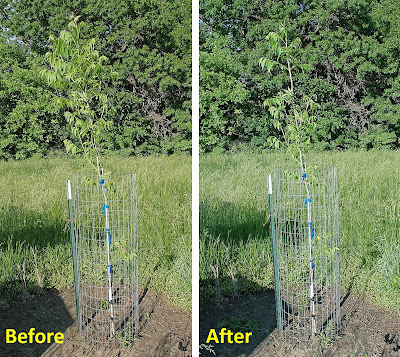Last week, I finished my grafting for the season. This week, I turned my attention to pruning last year's grafts. Many of the bark grafts I made last year grew 4 to 5 feet in height during their first summer, and by the time I got back to these trees this spring, they had put on another 12 to 18 inches of new growth (photo at right). However, grafted pecan trees never seem to grow the way we want them to grow. It was time to practice some directive pruning.
When I approach a young tree I always start by looking at the top of the tree (photo at right). When a pecan tree breaks bud in the spring, numerous buds at the tree's apex grow all at one time. This creates a very bushy top with no single, strong central leader.
After inspecting the tree, I choose one shoot to become the new central leader. In the photo at right, note that at the top of last year's growth, both primary and secondary bud broke and developed into new shoots. To prune the leader down to one shoot, I made two cuts (red lines in photo). I also removed several shoots below the leader following the "2 foot rule" for defining a new central leader.
Next I turned my attention to the central portion of the young tree's canopy. On this tree, I found several new lateral shoots growing very vigorously (photo at left). I definitely want to keep all these laterals on the tree to provide greater leaf area for the tree and help stimulate trunk diameter growth. However, I don't want the laterals to grow so long and leggy that they droop towards the ground or grow upright to complete with the leader.
To control lateral branch growth I simply pinch out the terminal growing point of each branch. Pinching will cause a pause in extension growth (growing longer) and stimulate radial growth (growing thicker). Eventually buds on lateral branches will break and the middle portion of the tree's canopy will fill out with additional branches and leaves.
Pinching out the tips of lateral branches is a simple process that you can perform with your fingers. When I pinch out the terminal of a lateral branch I always make sure to pinch just above an outward pointing bud (photo at left).
The photo above shows my young tree before and after directive pruning. The brushy top of the tree has been thinned down to a single central leader and I've kept all the new lateral branches in the tree's mid-section. What is hard to see in the photo is the fact that I pinched the terminal out of all laterals
The photo at right is another example of a tree I grafted last year that needed some pruning this spring. Two problems needed immediate attention. The strong lateral branch that originated from a bud on the scion must be removed so it won't compete with the central leader. And, I need to define a new central leader out of the profusion of branches growing at the top of the tree.
A close look at the top of the tree revealed at least 7 shoots trying to grow upwards (photo at left). I pruned this down to one shoot selecting a strong shoot that was growing parallel to my training stick.
After pruning to get a new central leader, I was left with a sharp dog leg on the main stem and a new shoot that was weakly attached to the tree (due to all the pruning cuts). To ensure I don't loose my new central leader in a wind storm, I tied the shoot to my training stick using flagging tape (photo at right).
The before and after photos of this second tree are a little more dramatic (photo above). You immediately notice that the lateral branch that grew from the original scion stick has been removed. Next you can see that the tree now has a single central leader at the top of the tree. And like the first tree I pruned, I left all the lateral branches arising form the central trunk but pinched out their terminals to slow extension growth.









